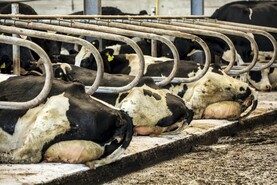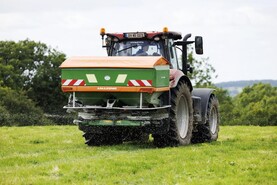The level of frustration among farmers with protected urea could be measured by the number of comments on social media to articles about protected urea, or indeed the packed crowd at Dairy Day during the protected urea discussion.
People have strongly held views on both sides of the debate, the debate being if protected urea is working as a source of nitrogen on Irish farms.
While there are many that use protected urea and find it works OK, or report no issues with it, there are plenty who have the opposite view.
In one camp are farmers who used protected urea in 2024 and noticed a very poor response in terms of grass growth.
Some of these farmers also noticed severe striping in fields when certain compounds containing protected urea was applied.
Teagasc are in another camp and saying that the trial work from 2024 is showing no difference in grass growth between protected urea and forms of nitrogen such as CAN and urea.
They say that bad weather during 2024 lead to poor growing conditions. Speaking at Dairy Day, David Wall from Teagasc said that those that used protected urea for the first time in 2024 are especially disappointed but that some are conflating the two issues and blaming protected urea when in fact it was the weather.
Teagasc are also pointing the finger at farmers themselves when it comes to spreading issues. Speaking at the Teagasc national dairy conference, Patrick Forrestal from Teagasc said that striping in 2024 is an issue caused by the incorrect calibration of the fertiliser spreader or the physical qualities of the fertiliser itself.
Meanwhile, the fertiliser industry, as in those that import and distribute fertiliser are on the fence about protected urea.
On the one hand they say they are inundated with farmer complaints about the product while on the other hand are blaming the technology itself for the problems with spreading protected urea.
Speaking at Dairy Day, Liam Dunphy from Gouldings said that the bulk density of urea is very different to the bulk density of CAN and he compared it to throwing a ping-pong ball in the case of urea to throwing a golf ball in the case of CAN meaning CAN will travel further.
He said hardness is also an issue and all urea has a lower hardness score than CAN and he said that this is magnified when a liquid chemical (the inhibitor) is applied to the urea making it protected urea.
If the hardness score is low, then there is a greater chance of that product breaking up when it hits the veins on the spreading discs and not covering the desired area.
Liam also said that fertiliser spreaders should be thoroughly washed out in between CAN and urea products to prevent mush from forming.
Plans for 2025
When it comes to planning the fertiliser strategy for 2025, the messages from the Dairy Day session, which included dairy farmer Tom Downey from Golden in Co Tipperary was to focus on straight protected urea first and foremost.
This is protected urea without any other nutrient included such as sulphur or potash and it was felt that this would spread easier as a result with less risk of striping.
Tom said that he was going to soil sample again this winter and if he had a P allowance he was going to apply 18:6:12.
On sulphur, he said he plans to use ASN fertiliser which is 26% nitrogen and 14% sulphur although Liam Dunphy said that this product may be in short supply next season.
While protected urea products like 29-0-14+S are useful in the sense that they cover off a wide range of nutrients, it does seem that it presented many farmers with challenges when it came to spreading it and these were really obvious in silage fields last summer.
The importance of setting up the fertiliser spreader correctly and getting it calibrated for the product cannot be overstated but this is not easy or quick to do.
Reverting back to CAN products is an option for farmers but this means higher greenhouse gas emissions for the sector and it also means that most dairy farmers would be locked out of the co-op sustainability programmes.
For me, the biggest stumbling block will be how to get sulphur incorporated into the fertiliser plan if it is not going to be used alongside protected urea.
If 18:6:12 is considered a sustainable fertiliser as the nitrogen is in ammoniacal form, then one would expect that a product like 18:0:12+S would be in high demand, if that could be manufactured.







 This is a subscriber-only article
This is a subscriber-only article










SHARING OPTIONS: